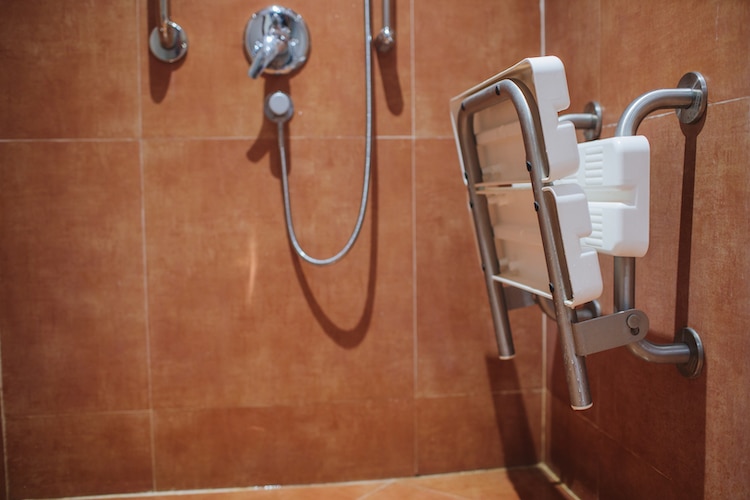10 Essential Bathroom Aids for the Elderly and Disabled
Updated July 2024
Bathroom aids are crucial in increasing the autonomy and independence of people with disabilities, mobility limitations, or balance issues. Whether you’re a caregiver, managing the care of a loved one, or needing extra support yourself, there are many types of bathroom adaptions and bathroom safety aids designed to make toileting, bathing, and showering easier, safer and more comfortable.
In this guide, we’ll explore 11 key bathroom aids for the elderly and disabled that can make a real difference when using the bathroom.
With over 30 years of experience, Age Care Bathrooms has designed and built thousands of mobility bathrooms. Contact our team of bathroom experts by phone or via our online form, and we will assist you in selecting the bathroom that best suits your requirements.
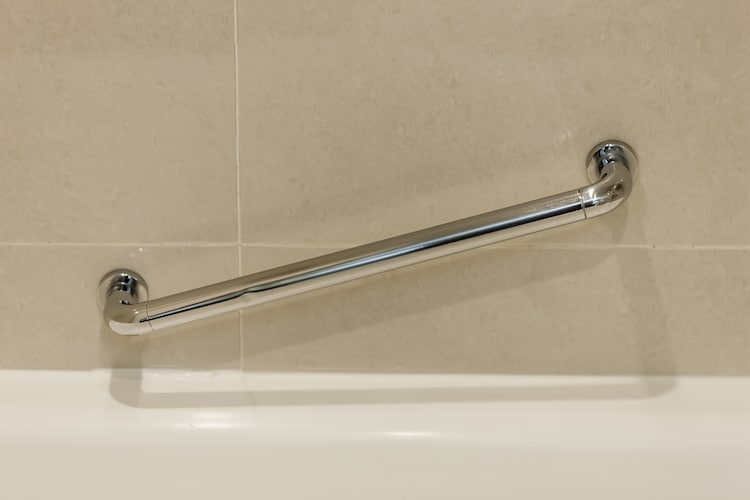
1. Safety Rails and Grab Bars
If you or a loved one has mobility challenges, the simple act of getting in and out of the bath can be daunting. Safety rails and grab bars are some of the most beneficial bathroom aids for elderly or disabled people. Not only do they provide vital support and help prevent falls, but grab rails can make getting in and out of the bath or on and off the toilet far less stressful.
Inexpensive and easy to fit, they can be installed around the bathtub, shower, and toilet. Available in various sizes and finishes such as chrome, bronze, or white plastic, safety rails and grab bars can be strategically placed to blend in with other bathroom fixtures and features. Options include static or folding rails and even suction cup-mounted bars for temporary disabled or elderly bathing needs.
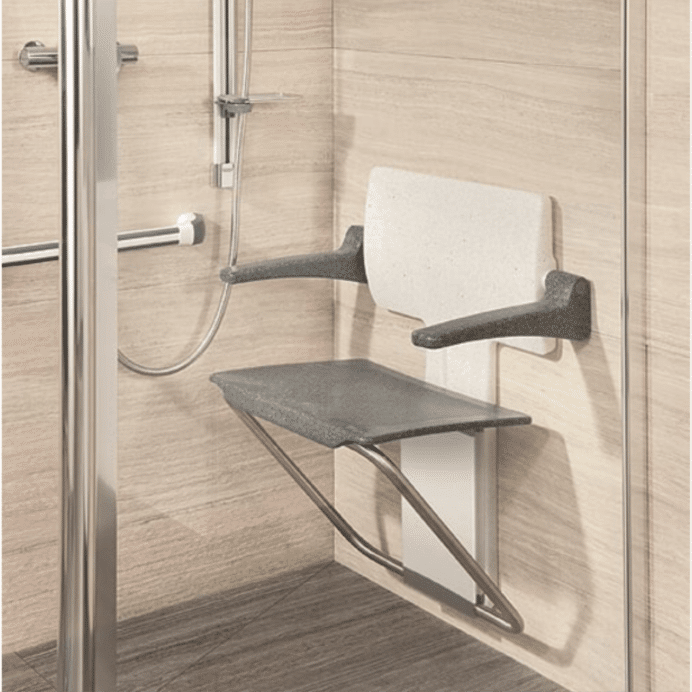
2. Shower Chairs and Stools
Shower chairs and stools are essential if you or someone you care for finds it difficult to stand for extended periods. These bathroom aids allow you to sit comfortably while showering, enhancing safety and comfort. Available in various styles and sizes, they are easy to clean and durable.
Different types of shower chairs and stools provide varying levels of support to accommodate a range of mobility issues and personal preferences. Choosing the right one can greatly enhance safety and comfort for elderly and disabled people while showering. Here are some options to consider:
– Corner shower stools
Corner shower stools are designed to fit snugly in the corner of the shower, maximising space and providing a stable seating option. They are ideal for individuals who need minimal support but benefit from having a place to sit while showering. These stools are often compact, making them suitable for smaller shower areas.
– Shower stools with rotating seats
Shower stools with rotating seats offer enhanced convenience and ease of movement. The rotating seat allows users to turn without straining, making it easier to wash different parts of the body and transfer on and off the stool. This type of stool is especially beneficial for people with difficulty twisting or turning.
– Shower chairs with backs and armrests
Shower chairs with backs and armrests provide a higher level of support and stability. The backrest offers additional support for the upper body, while the armrests assist with balance and provide leverage for sitting down and standing up. These chairs are ideal for people who need back support due to mobility issues, arthritis, or balance problems.
– Shower commode chairs on wheels
Using a wheeled shower chair can be safer than transferring from a wheelchair to a chair or seat inside a shower and is extremely convenient for use in mobility wet rooms. Various styles of commodes are available with a choice of arm, back and footrests. Two of the most popular types are:
- Self-propelled shower chairs: These chairs allow individuals to get into and out of the shower without assistance, helping to increase autonomy. They can also come fitted with a commode if required.
- Shower commode chairs: Combining the functions of a shower chair and a commode, shower commode chairs on wheels are extremely versatile. The wheels allow for easy movement into and out of the shower, and the commode feature means they can be used as a toilet as well. This dual functionality reduces the need for multiple bathroom aids and is particularly useful for people with dementia or severe mobility challenges.
– Foldaway shower seat
Easily mounted to the wall and neatly folded away when not in use, foldaway shower seats make showering safer and more comfortable, especially if you suffer from mobility issues. They are available with arms and legs for added stability and a padded seat for additional comfort and support. In addition to reducing the risks of slips and falls, this shower seat can help transform your shower into a spa-like experience.
Related Reading: Accessible Shower Guide: Types of Showers and How They Can Help
3. Transfer Benches
Transfer benches are a popular bath aid for disabled or older people. These benches extend over the side of the bathtub to provide support when getting into and out of the bath. They have a seat that extends over the side of the tub, allowing the user to sit down and slide their legs into the tub. They are designed to support people who have difficulty standing up or sitting down or have balance issues.
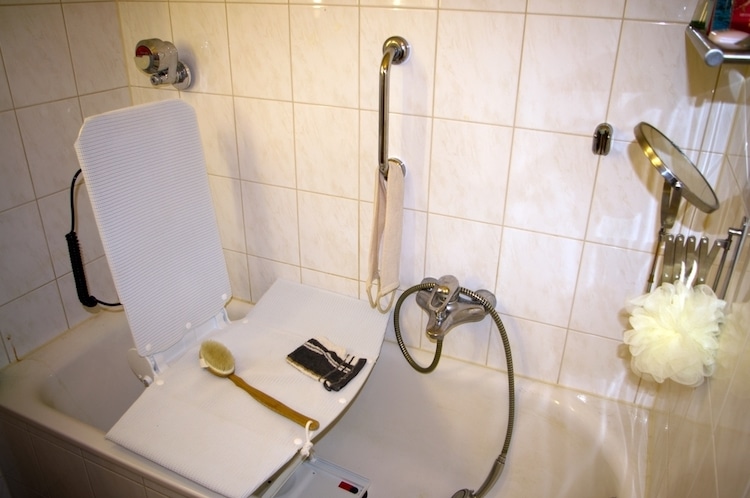
4. Rising Bath Lifts
Are you or someone you care for finding it more and more challenging to enter and exit the bath? If you are not ready to swap your regular bath with a walk-in bath, a bath lift can assist by slowly easing you into the water and bringing you back up. Before looking for a bath lift, it’s crucial to measure the bath to ensure it will fit and function correctly. Crucial for wheelchair users or those with limited trunk control, a rising bath lift can allow independent bathing for many years to come.
An alternative for people who are more mobile but still find it difficult to get in and out of the bath is a rising bath cushion. These cushions inflate and deflate to comfortably raise or lower you into the bath. This bath aid for elderly and disabled people is a portable, low-cost solution that can make bathing safer, easier, and more relaxing if you struggle with mobility issues but maintain reasonable trunk control.
5. Bath Seats and Chairs
Portable bath seats can be handy by providing extra support when bathing. Unlike rising bath lifts, they do not go up and down and are best for use with a walk-in bath for individuals who want to feel more secure and comfortable while in the bath but can get up and down without assistance.
6. Bath Step
If you or someone you know is living with mobility problems, dementia, or visual impairments, a bath step helps to reduce the distance required to step up into the bath. Bath steps work by gripping firmly to your bathroom floor, providing extra support when it comes to getting in and out of the bath.
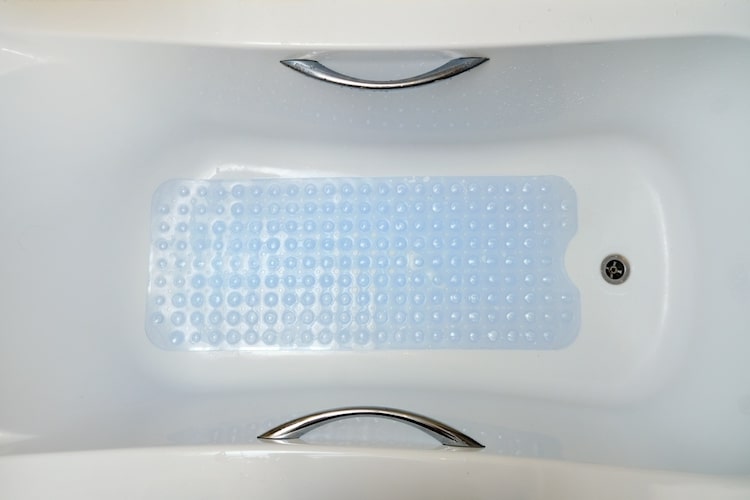
7. Slip-Resistant Mat
Investing in an anti-slip mat is one of the best ways to help prevent slips and falls in the bathroom. These mats should be placed:
- Inside the bath or shower
- Outside the bath or shower
- Around a toilet
- Under a sink.
8. Washing and Personal Care Aids
Once safely inside your bath or shower enclosure, washing itself can become a little tricky — and this is where washing and personal aids make all the difference. From scrub brushes with bendable handles for arthritis sufferers to curved designs for those recovering from shoulder or neck injuries, there are a variety of aids for different needs.
You can also pick up longer bath brushes with soap inserts. Not only can these types of bathing accessories assist with lathering up, but they also reduce the chance of the soap being dropped. A few of the key bathroom aids available with extra long and bendable handles are:
- Sponges
- Back washers
- Toe washers
- Foot scrubbers
- Hair washers
- Lotion applicators
Always ensure these personal care aids are easy to reach when bathing or showering.
9. Hair Washing Tray
Although someone with a disability, limited mobility, or dexterity problems may be able to wash independently, they may still find washing their hair difficult. A hair-washing tray makes it easier to shampoo another person’s hair while they are sitting upright. The user’s shoulders support the tray, which has a surround to keep it securely in place.
Related Reading: Dementia Support: Personal Hygiene and Bathing Guide
10. Raised Toilet Seats
Raised toilet seats enable you to sit down with less of a drop and reduce the effort needed to stand up again after using the toilet. To provide you with more assistance while getting up from the toilet, some raised toilet seats also have support arms or the option to add them if required.
Raised toilet seats can be especially helpful for people who struggle to sit down or stand up from the toilet. Available in various heights and with wheels for ease of movement, they reduce the risk of falling onto the toilet bowl and fractures or broken bones.
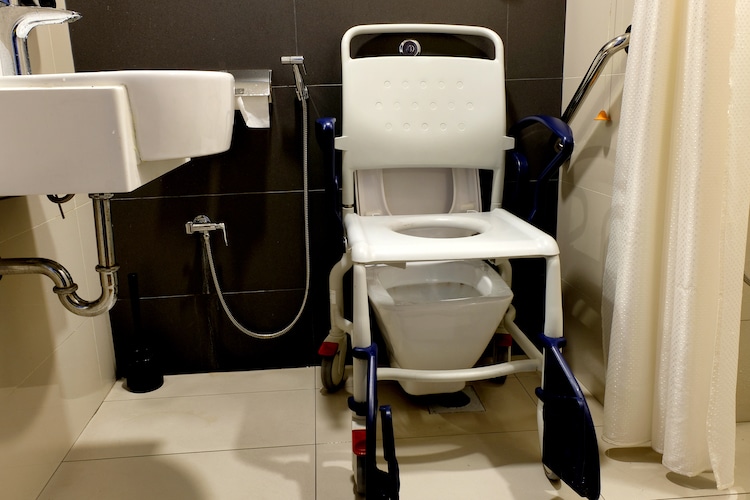
11. Toilet Frames
Mobility issues and conditions that arise with older age can make essential everyday toilet trips somewhat challenging. This means that toilet frames are fast becoming one of the more popular bathroom accessories for assisting with these difficulties.
Lowering onto and rising from a toilet seat can put pressure on specific areas, such as the knees and joints, which can become painful over time.
Adding a toilet frame provides extra support when sitting on and getting up from the toilet. Certain models also come with height-adjustable handles, adjustable widths and moulded seats for additional comfort. Depending on your preference, they can be fixed to the floor or portable.
At Age Care Bathrooms, our team of bathroom experts and installers has been designing and constructing mobility bathrooms for over 30 years. Use our online form or call our friendly team of bathroom specialists in the UK for advice or to book a free home survey.
Bathroom Aids FAQ
1. What can be used if a person can not walk to the toilet?
If a person is unable to walk to the toilet, several options can be used to assist with toileting:
- Handheld urinal or bedpan
- Commode chair
- Shower commode chair.
2. What are toileting aids used for?
Toileting aids assist people who have difficulty using a standard toilet due to mobility, balance, or strength issues. In addition to providing support and reducing the risk of slipping or falling, toilet aids are vital to increase comfort and independence. Common toileting aids include raised toilet seats, grab bars, toilet frames, and commode chairs.
3. What is the best aid for getting out of a bath?
The best aid for getting out of a bath depends on mobility needs, but commonly used aids include:
- Bath lifts: Battery-operated devices that lower and raise a person in and out of the bath
- Grab bars: Installed on the walls behind and around the bath, grab bars provide extra support when getting in and out of the bath
- Bath transfer benches: Benches that extend over the tub edge to help slide in and out
- Non-slip mats: Mats to prevent slipping in the bath when standing
- Bath steps: Steps to make getting in and out easier.
4. Can you get free bathroom aids from the NHS?
Yes, you can get free mobility aids from your local council if you’re disabled from your local council. Here are the steps:
- Home assessment: An occupational therapist will visit you at home. During the assessment, they will ask you questions and follow you around to assess how you can improve your mobility and safety around your home.
- Equipment: Following the assessment and referral, the NHS provides the required mobility aids, which can include items like wheelchairs, walking aids, or bath aids.
You can also apply for a disabled facilities grant (DFG) for more costly adaptations, such as installing a mobility wet room or a walk-in bath.
For over 30 years, Age Care Bathrooms has been creating and building mobility bathrooms. We can assist you in selecting the bathroom that best suits your needs. Just give our team of bathroom experts a call or complete our online form to arrange a free home survey.




